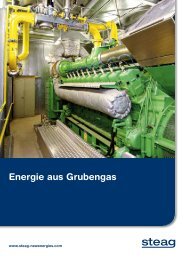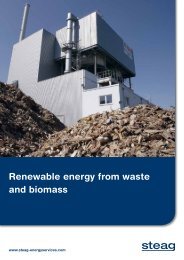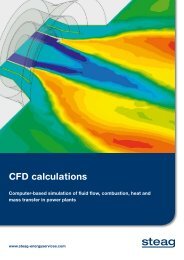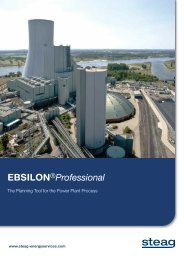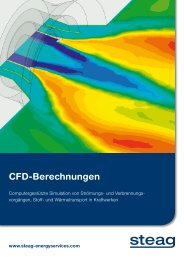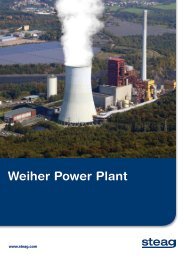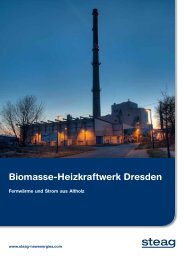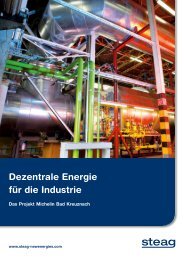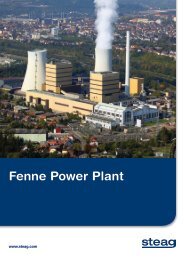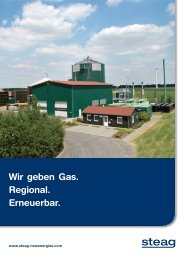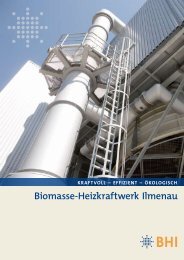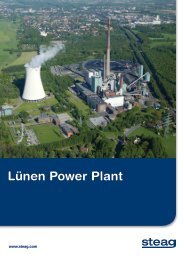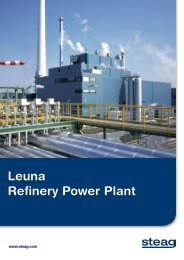Voerde Power Plant - STEAG
Voerde Power Plant - STEAG
Voerde Power Plant - STEAG
- No tags were found...
Create successful ePaper yourself
Turn your PDF publications into a flip-book with our unique Google optimized e-Paper software.
<strong>Voerde</strong> <strong>Power</strong> <strong>Plant</strong>www.steag.com
<strong>Power</strong> and heat for the future<strong>Power</strong> plants in double packAs fifth biggest electricity producer in Germany, with ultramodernpower plants in and outside Germany and a variety ofservices, <strong>STEAG</strong> GmbH safeguards the energy supply of thefuture – reliably, efficiently, and with low environmental impact.<strong>STEAG</strong> blazes the trail for the energy sources biomass,biogas, mine gas, geothermics, wind and solar thermics. Theengineers of <strong>STEAG</strong> Energy Services GmbH develop, buildand operate power plants all over the world and are expertsfor the modernization of existing plants and for made-tomeasureenergy supply which goes easy on the climate andat the same time is economical.<strong>Power</strong> plants at home and abroad<strong>STEAG</strong> operates eleven power plants at ten locations inGermany with an installed capacity of about 7,500 MW; nineof these plants use hard coal as primary energy source. Attwo sites, each of which integrates an industrial power plant,refinery by-products also are used to produce steam, compressedair and electricity. Most of the electricity from hardcoal is supplied to industrial and public utilities. The customersinclude RWE, EnBW and Deutsche Bahn, the GermanRailways. Where there is a demand for it, cogeneration –the simultaneous production of power and useful heat – ispracticed. This heat either is used for heating purposes oris purchased by industrial enterprises in the form of processheat for their production processes. Outside Germany, too,the company contributes to public power supply with threehard-coal-fired power plants, capacity about 1,700 MW, inTurkey, Colombia and the Philippines. The efficient powerplants of <strong>STEAG</strong> make an active contribution to a secure andsustainable supply of energy.<strong>STEAG</strong> operates two power plants at the <strong>Voerde</strong> site: <strong>Voerde</strong>and West, each with two units. With an installed capacity of2,234 megawatts (MW), <strong>Voerde</strong> is <strong>STEAG</strong>‘s biggest powerplant site. The two units of power plant West are whollyowned by <strong>STEAG</strong>, while the two units of <strong>Voerde</strong> belong toKraftwerk <strong>Voerde</strong> <strong>STEAG</strong>-RWE oHg, in which <strong>STEAG</strong> holdsa 75 percent stake. RWE owns the remaining 25 percent.Around 7.5 billion kilowatt-hours (kWh) of electricity annuallyare generated at the <strong>Voerde</strong> site. This is enough to supply theelectricity needs of 1.9 million single-family households. Thecoal yard holds 350,000 tons of coal; this capacity permitsoffsetting fluctuations in delivery and consumption.The <strong>Voerde</strong> site has three stacks with heights of 230, 218 and250 meters (the 250-meter stack has been out of operationsince 2005). The 230-meter stack was erected in 2005 in connectionwith the partial renewal of the flue gas desulfurizationplant and is used by the units <strong>Voerde</strong> A and B. The 218-meterstack belongs to the units West I and West II. A public roadleads through the site, Frankfurter Strasse, which connectsthe town of <strong>Voerde</strong> with Dinslaken and Duisburg-Walsum.Optimal location on the RhineThe location on the Rhine River affords optimal conditions for<strong>Voerde</strong>: coal can be transported by ship and delivered to theplant by rail, a competitive and environment-friendly procedure.Gypsum, fly ash and granulate in turn leave the power plant byship. The Rhine ensures the supply of water to the plant.
The power plant processUp to 1,200 tons of hard coal per hour can be transferredfrom storage to the coal bunker of the <strong>Voerde</strong> power plant.From there, in the same period of time as much as 72 tonsgo to each coal mill. The mills pulverize the fuel, which isdried with hot air and then burned in the furnace.During combustion, hot flue gas is formed. As it passes overkilometers of tubes in the steam generator, the flue gas heatswater to make steam. The steam, which reaches a temperatureof up to 530 °C and is under high pressure, is conductedinto a turbine where it impacts the turbine blades andcauses the turbine shaft to rotate.A connected generator produces electricity from this motion,like a dynamo. Transformers bring the electricity up to thenecessary voltage and feed it into the grid.When the steam has finished its work in the turbine it is conductedinto a condenser. This is a large heat exchanger withmany tubes in which cooling water circulates. The steamcomes in contact with the tubes and forms droplets (condensation),much like humid air on a cold window pane. Thecondensed water droplets are collected and pumped backinto the boiler to complete the cycle.In the process the cooling water from the condenser heatsup from about 20 °C to 30 °C. It is piped into cooling towerswhere it cascades down and cools off again. A small portionevaporates and is replaced by water from the Rhine River.Only pure water vapor escapes from the cooling towers.Protecting the environmentSchematic illustration of the power plant processFrom the viewpoint of physics, energy is not produced, but merely transformed. The energy is fixed to the coal in chemical form. The coal is burned in theboiler; the released heat heats up water. This gives rise to hot steam (thermal energy) which drives a turbine (mechanical energy). A connected generatorthen transforms this mechanical energy into electricity (electrical energy).When coal is fired, flue gases form which contain mainlyparticles of ash, dust, nitrogen oxides and sulfur dioxide.For many years <strong>STEAG</strong> has been using highly effective methodsto reduce the emissions of these substances. When apower plant is built today, a third of the expenditure goes intoenvironmental protection, most of it into air pollution control.<strong>STEAG</strong> will make substantial investments in environmentalprotection in future too. The emissions of the power plantare continuously measured. The company‘s environmentalprotection officers monitor and evaluate the measurements.In addition they have independent bodies like the Germaninspecting authority TÜV make measurements.Natural diversity around the power plantIn the vicinity of the <strong>Voerde</strong> plant, <strong>STEAG</strong> manages the 500hectare „Rheinaue Walsum“. This river meadow landscape isin a near-natural state and features a great ecological diversity,providing a habitat for a host of rare plant and animal species,including stone martens, dragonflies, peewits, black-tailedgodwits and mute swans. Immediately adjoining the plantsite are 200 contiguous hectares of mixed woodland, which<strong>STEAG</strong> also keeps in a near-natural state. An extensive networkof bicycle paths and hiking trails provides access to meadowsand woodland, which serve as a greenbelt recreationarea. Not far from the power plant is the „Scholtenhof“ estate,where <strong>STEAG</strong> practices organic farming on 300 hectares ofland. The products are marketed in the farm‘s own shop.Valuable by-productsThe <strong>STEAG</strong> subsidiary <strong>STEAG</strong> <strong>Power</strong> Minerals GmbH is responsiblefor recycling the by-products of all <strong>STEAG</strong> hard-coalfiredpower plants in Germany. <strong>Power</strong> plant by-products whichoriginate in the firing process are valuable and are marketed:The by-products include fly ash, boiler sand, slag tap granulateand FGD gypsum.These power plant by-products are environmentally soundand can be used in almost all applications as constructionmaterials without impairing the soil or groundwater. Treatmentis only necessary in special cases. In contrast to the naturalresources which are becoming increasingly scarce, powerplant by-products will be available in the longer term, conservingnatural raw materials.
Data and facts *Installed capacitySteam rating per unitSteam pressure in turbineTotal: 2,234 MW<strong>Power</strong> plant <strong>Voerde</strong>: 1,522 MW<strong>Power</strong> plant West: 712 MW980 to 2,160 t / h180 barSteam temperature 530 °CUseful electricity outputAnnual coal consumptionComponentsCooling towerWater vapor escaping from cooling towerDust removalFlue gas desulfurization (FGD)NO xremoval (DeNO x)By-products7.5 billion KWh / aabout 2,890,000 t / 2,520,000 tce2 pulverized coal (PC) fired Benson boilers - wet ash removal (980 t / h each)2 PC-fired Benson boilers – dry ash removal (2,160 t / h)4 turbine generators (2 x 356 MW, 2 x 761 MW)Height 161 meters2,000 m 3 / hElectrostatic precipitatorWet scrubbing with lime slurryCatalytic SCR processGranulate, furnace bottom ash, fly ash, gypsumInitial start-up West I and II: 1970 / 71<strong>Voerde</strong> A and B: 1982 / 85OperatorOwner<strong>Power</strong> <strong>Plant</strong> <strong>Voerde</strong>: <strong>STEAG</strong> GmbH<strong>Power</strong> <strong>Plant</strong> West: <strong>STEAG</strong> GmbH<strong>Power</strong> <strong>Plant</strong> <strong>Voerde</strong>: <strong>STEAG</strong> GmbH und RWE <strong>Power</strong> AG<strong>Power</strong> <strong>Plant</strong> West: <strong>STEAG</strong> GmbHA site with a tradition<strong>STEAG</strong> refers to the gross maximum capacity under nominalconditions as installed capacity. This is the continuousoutput that can be attained under normal conditions. It islimited by the weakest part of the plant (bottleneck), is determinedby measurement and converted to normal conditions;stated in MW, calculated as MW electric and equivalent(thermal output).The standard coal equivalent or ton of coal equivalent(tce) is a commonly used unit of measure in Central Europe,though not a statutory unit of measure, to compare the energycontent of primary energy sources. 1 ton coal equivalent =29.3076 gigajoules (GJ) = 8.141 thermal megawatt-hours(MWh th).At the <strong>Voerde</strong> site the power plant with two 350 MW units(West I and West II) was erected in 1970 / 71. In 1982 unitA of <strong>Voerde</strong> (710 MW) followed, and in 1985 <strong>Voerde</strong> B, alsowith 710 MW. Both units were equipped with flue gas desulfurization(FGD) systems. In 1987 flue gas desulfurizationsystems also were installed in the West units.The installation of nitrogen oxide reduction systems in bothpower plants then followed in 1989. In December 2005 thetwo FGD systems of the <strong>Voerde</strong> units were partially renewed,increasing the capacity of each unit by 51 MW.* as at December 31, 2011



